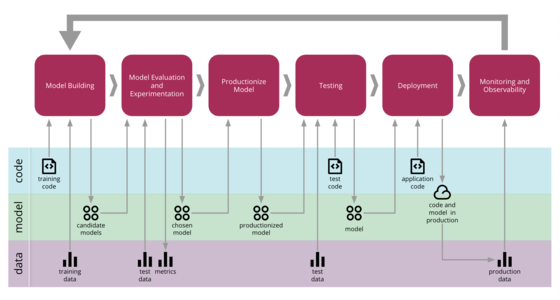October ’19 DVC❤️Heartbeat
Every month we are sharing here our news, findings, interesting reads, community takeaways, and everything along the way.
Some of those are related to our brainchild DVC and its journey. The others are a collection of exciting stories and ideas centered around ML best practices and workflow.
News and links
Autumn is a great season for new beginnings and there is so much we love about it this year. Here are some of the highlights:
-
Co-hosting our first ever meetup! Our Dmitry Petrov partnering with Dan Fischetti from Standard Cognition to discuss Open-source tools to version control Machine Learning models and experiments. The recording is available now here.
- Getting ready for the Hacktoberfest and having the whole team get together to pick up and label nice issues and be ready to support the contributors.
- Discovering some really cool blogposts, talks and tutorials from our users all over the world: check this blogpost in French or this tutorial in German!
- Having a great time working with a tech writer brought to us by the Google Season of Docs program. Check out these interactive tutorials we’ve created together.
- Having hot internal discussion about Discord vs Slack support/community channels. If you are on the edge like us, have a look at this discussion in the Rust community, so helpful.
-
Seeing Dmitry Petrov being really happy one day:
.@martinfowler's books and his website were always the source of programming wisdom 💎 His Refactoring book is the first book I recommend to developers.
— Dmitry Petrov (@FullStackML) September 5, 2019
Now they write about ML lifecycle and automation. I’m especially excited because they use @DVCorg that we’ve created. https://t.co/HwswZqjOsb
We at DVC.org are so happy every time we discover an article featuring DVC or addressing one of the burning ML issues we are trying to solve. Here are some of the links that caught our eye past month:
- Continuous Delivery for Machine Learning by Danilo Sato, Arif Wider, Christoph Windheuser and curated by Martin Fowler.
As Machine Learning techniques continue to evolve and perform more complex tasks, so is evolving our knowledge of how to manage and deliver such applications to production. By bringing and extending the principles and practices from Continuous Delivery, we can better manage the risks of releasing changes to Machine Learning applications in a safe and reliable way.
So, the first question is clear: how to choose the optimal hardware for neural networks? Secondly, assuming that we have the appropriate infrastructure, how to build the machine learning ecosystem to train our models efficiently and not die trying? At Signaturit, we have the solution ;)
The Path to Identity Validation (2/3)

My talk will focus on Version Control Systems (VCS) for big-data projects. With the advent of Machine Learning (ML) , the development teams find it increasingly difficult to manage and collaborate on projects that deal with huge amounts of data and ML models apart from just source code.
- Podcast: TWIML Talk #295 Managing Deep Learning Experiments with Lukas Biewald
Seeing a need for reproducibility in deep learning experiments, Lukas founded Weights & Biases. In this episode we discuss his experiment tracking tool, how it works, the components that make it unique in the ML marketplace and the open, collaborative culture that Lukas promotes. Listen to Lukas delve into how he got his start in deep learning experiments, what his experiment tracking used to look like, the current Weights & Biases business success strategy, and what his team is working on today.
Discord gems
There are lots of hidden gems in our Discord community discussions. Sometimes they are scattered all over the channels and hard to track down.
We are sifting through the issues and discussions and share with you the most interesting takeaways.
Q: I’ve just run a dvc run step, and realised I forgot to declare an output file. Is there a way to add an output file without rerunning the (computationally expensive) step/stage?
If you’ve already ran it, you could just open created DVC-file with an editor
and add an entry to the outs field. After that, just run dvc commit my.dvc and
it will save the checksums and data without re-running your command.
dvc run --no-exec would also work with commit instead of modifying the
DVC-file by hand.
Q: For metric files do I have to use dvc run to set a metric or can I do it some other way? Can I use metrics functionality without the need to setup and manage DVC cache and remote storage?
Any file that is under DVC control (e.g. added with dvc add or an output in
dvc run -o) can be made a metric file with dvc metrics add file. Alternatively
a command dvc run -M file makes file a metric without caching it. It means dvc
metrics show can be used while file is still versioned by Git.
Q: Is there a way not to add the full (Azure) connection string to the .dvc/config file that is being checked into Git for using dvc remotes? I think it’s quite unhealthy to have secrets checked in SCM.
There are two options — use AZURE_STORAGE_CONNECTION_STRING environment
variable or use --local flag that will put it into the .dvc/config.local
that is added to the .gitignore, so you don’t track it with it and so won’t
expose secrets.
Q: I would like to know if it is possible to manage files under DVC whilst keeping them in their original locations (e.g. on a network drive in a given folder structure)? If I want to add a large file to be tracked by DVC, and it is in a bucket on S3 or GCS, can I do that without downloading it locally?
Yes, you are probably looking for external dependencies and outputs. This is the link to the documentation to start.
Q: How do I setup DVC so that NAS (e.g. Synology) acts as a shared DVC cache?
Using NAS (e.g. NFS) is a very common scenario for DVC. In short you use
dvc cache dir to setup a cache externally. Set cache type to use symlinks and
enable protected mode. We are preparing a
document
how to setup the NFS as a shared cache, but I think it can be applied to any
NAS.
Q: So I have some data that is in the hundreds of gigs. If I enable symlink, hardlink strategy and cache protecting, will DVC automatically choose this strategy over copying when trying to use dvc add?
Yes, it will! Here is some clarification. So when you set those settings like
that, dvc add data will move data to your cache and then will create a
hardlink from your cache to your workspace.
Unless your cache directory and your workspace are on different file systems, move should be instant. Please, find more information here.
Q: My repo’s DVC is “busy and locked” and I’m not sure how it got that way and how to remove/diagnose the lock. Any suggestions?
DVC uses a lock file to prevent running two commands at the same time. The lock
file
is under the .dvc directory. If no DVC commands running and you are still
getting this error it’s safe to remove this file manually to resolve the issue.
Q: I’m trying to understand how does DVC remote add work in case of a local folder and what is the best workflow when data is outside of your project root?
When using DVC, in most cases we assume that your data will be somewhere under project root. There is an option to use so called external dependencies, which is data that is usually too big to be stored under your project root, but if you operate on data that is of some reasonable size, I would recommend starting with putting data somewhere under project root. Remotes are usually places where you store your data, but it is DVC task to move your data around. But if you want to keep your current setup where you will have data in different place than your project, you will need to refer to data with full paths. So, for example:
- You are in
/home/gabriel/myprojectand you have initialized dvc and git repository - You have
featurize.pyin your project dir, and want to use data to produce some features and thantrain.pyto train a model. - Run the command:
$ dvc run -d /research_data/myproject/videos \
-o /research_data/myproject/features \
python featurize.pyto tell DVC, that you use /research_data/myproject/videos to featurize, and
produce output to your features dir. Note that your code should be aware of
those paths, they can be hardcoded inside featurize.py, but point of dvc run
is just to tell DVC what artifacts belong to currently defined step of ML
pipeline.
Q: When I run du command to check how much space DVC project consumes I see that it duplicates/copies data. It’s very space and time consuming to copy large data files, is there a way to avoid that? It takes too long to add large files to DVC.
Yes! You don’t have to copy files with DVC. First of all, there are two reasons
when du can show that it takes double the space to store data under DVC control.
du can be inaccurate when the underlying file system supports reflinks (XFS on
Linux, APFS on Mac, etc). This is actually the best scenario since no copying is
happening and no changes are required to any DVC settings. Second, case means
that copy semantics is used by default. It can be turned off by providing cache
type symlinks, hardlinks. Please, read more on this
here.
Q: How can I detach a file from DVC control?
Just removing the corresponding DVC-file and running dvc gc after that should
be enough. It’ll stop tracking the data file and clean the local cache that
might still contain it. Note! Don’t forget to run dvc unprotect if you use
advanced DVC setup with symlinks and hardlinks
(cache.type config option is not default). If dvc gc behavior is not
granular enough you can manually find the by its cache from the DVC-file in
.dvc/cache and remote storage. Learn
here
how they are organized.
Q: I’m trying to understand if DVC is an appropriate solution for storing data under GDPR requirements. That means that permanent deletion of files with sensitive data needs to be fully supported.
Yes, in this sense DVC is not very different from using bare S3, SSH or any other storage where you can go and just delete data. DVC can give a bit of overhead to locate a specific file to delete, but otherwise it’s all the same you will be able to delete any file you want. See more details on how you retrospectively can edit directories under DVC control here.
If you have any questions, concerns or ideas, let us know in the comments below or connect with DVC team here. Our DMs on Twitter are always open, too.

